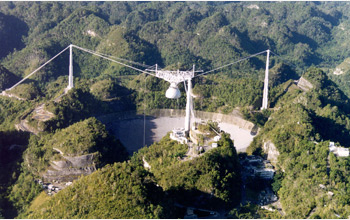All Images
News Release 10-140
Citizen Scientists Discover Rotating Pulsar
Einstein@Home project uses data from Arecibo, the world's largest and most sensitive radio telescope
This material is available primarily for archival purposes. Telephone numbers or other contact information may be out of date; please see current contact information at media contacts.

Arecibo Observatory, an NSF facility operated by Cornell University, is in Arecibo, Puerto Rico.
Credit: Courtesy of the NAIC - Arecibo Observatory, a facility of the NSF
Download the high-resolution JPG version of the image. (614 KB)
Use your mouse to right-click (Mac users may need to Ctrl-click) the link above and choose the option that will save the file or target to your computer.
Citizen scientists Chris and Helen Colvin from Ames, Iowa, and Daniel Gebhardt from Mainz, German participate in Einstein@Home, a distributive data program that involves a quarter of a million volunteers worldwide. They contributed their idle computers to analyze data gathered by the world's largest and most sensitive radio telescope, the Arecibo Observatory in Puerto Rico, and discovered a rotating pulsar. They remotely join NSF's Lisa-Joy Zgorski along with Einstein@Home director Bruce Allen and Arecibo researcher Jim Cordes. Their findings are published in the online journal Science Express (Aug. 12, 2010).
Credit: Cornell University/University of Mainz/Einstein@home/Iowa State University

Einstein@Home screen shot. About one-third of Einstein@Home's computing capacity is used to search Arecibo data.
Credit: Einstein@Home
Download the high-resolution JPG version of the image. (57 KB)
Use your mouse to right-click (Mac users may need to Ctrl-click) the link above and choose the option that will save the file or target to your computer.

The Arecibo Observatory in Puerto Rico, an NSF facility operated by Cornell University, is the world's largest and most sensitive radio telescope. The PALFA, in the dome, is the pulsar detector.
Credit: Courtesy of the NAIC - Arecibo Observatory, a facility of the NSF
Download the high-resolution JPG version of the image. (3.5 MB)
Use your mouse to right-click (Mac users may need to Ctrl-click) the link above and choose the option that will save the file or target to your computer.

An artist's conception of the position of the pulsar PSR J2007+2722 (red circle) in the constellation of Vulpecula in the evening sky in August; constellations art overlaid for illustrative purposes.
Credit: Benjamin Knispel, Albert Einstein Institute
Download the high-resolution JPG version of the image. (608 KB)
Use your mouse to right-click (Mac users may need to Ctrl-click) the link above and choose the option that will save the file or target to your computer.
Artist's simulation of the newly discovered pulsar, PSR J2007+2722, as seen from the Earth. In the second half of the animation, the rotation (white) and magnetic (yellow) axes and the line of sight (blue dot) are visible. The observed pulse profile is shown below the animation. The radio emission cone shows the beam intensity (yellow ring) explaining the pulse profile.
Credit: Oliver Bock/Albert Einstein Institute
Artist's simulation of the newly discovered pulsar, PSR J2007+2722, as viewed from the side. In the second half of the animation, the rotation (white) and magnetic (yellow) axes and the line of sight (blue dot) are visible. The observed pulse profile is shown below the animation. The radio emission cone shows the beam intensity (yellow ring) explaining the pulse profile.
Credit: Oliver Bock/Albert Einstein Institute

Play Audio
The pulsar's radio signal waveform when interpreted as an audio signal.
Credit: Oliver Bock/Albert Einstein Institute

This paper appears in the Aug. 12 online journal Science Express.
Credit: Copyright AAAS 2010
Download the high-resolution JPG version of the image. (857 KB)
Use your mouse to right-click (Mac users may need to Ctrl-click) the link above and choose the option that will save the file or target to your computer.


